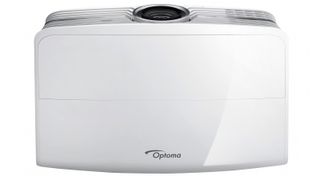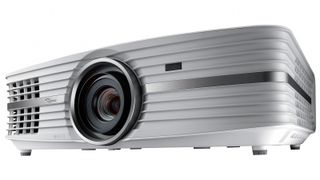Why you can trust TechRadar
Performance
This, if we're honest, is where we’d expect the UHD60’s wheels to come off. But they don’t. Not even a little bit.
For starters we were immediately blown away by the incredible sharpness of its images. Just a few frames of Ultra HD Blu-ray are enough to reveal what genuinely looks like the real 4K deal. Detail levels, clarity and pixel density are both substantially up on anything you’d see on a mere HD projector, or tellingly, from any from pseudo 4K projectors. We’re talking levels of detail here that seem at least a match for those of Sony’s native 4K projectors. This really is pretty amazing considering we’re talking about a $2,000 projector.
Even better, this genuinely startling 4K detailing is delivered for the vast majority of the time without so much as a hint of the fizzing or grain that can so often be an issue with HD single-chip DLP technology. Instead, aside from one or two slightly fizzy skies, you get a beautifully polished, crisp image that only looks grainy when it’s supposed to. As in, when grain is there in the content.
Once you’ve stopped ogling its phenomenal sharpness, you start to take in just how well the UHD60 handles HDR - so long, anyway, as you stick with the HDR picture mode.

Colours, in particular, look much more vibrant and rich in saturation, immediately making the image look more solid, three dimensional and natural, as well as more flat-out beautiful. The UHD60, understandably, is less exciting when it comes to delivering the much wider luminance range associated with HDR material. Experience has already shown that even 3000 lumens of brightness isn’t enough to get the same dramatic HDR light impact from a projector that you can get from a high-end TV.
Crucially, though, the UHD60 does a surprisingly good job of both tone mapping details in the brightest parts of HDR images, and retaining a watchable light balance so that you don’t have to worry about dark HDR scenes looking devoid of detail, or shadowy areas turning into mere silhouettes. These sorts of problems have ruined HDR playback on way more expensive projectors than the UHD60.
It feels to me as if the UHD60 may be ‘cheating’ slightly to achieve its unexpectedly good HDR images, maybe by raising the baseline brightness level higher than it should be if it was really serious about reproducing as wide a sense of possible of the HDR image’s full luminance range. But if we're right about this then Optoma has made 100% the right decision, as its HDR images are far more engaging and natural looking (ironically) than those of almost all remotely affordable HDR projector rivals.

While it’s becoming easier almost daily to find native 4K content to feed the UHD60, if you do find yourself having to revert to HD Blu-ray on occasion again the UHD60’s got your back. Its HD to 4K upscaling, for starters, is pretty much exemplary, adding plenty of detail and crispness without excessively exaggerating noise or introducing overt colour errors.
The UHD60 also handles SDR contrast and colour levels superbly well if you use the Cinema or Reference presets, giving no hint that SDR performance has had to be compromised to deliver such surprisingly strong and effective HDR. The only sign with SDR that this is an HDR-friendly projector is how bright SDR images look - but since this is achieved without spoiling contrast or making colours look bleached, it’s a positive thing, not a negative. Especially as it helps the UHD60’s picture remain unusually watchable in ambient light.
Inevitably for its money, the UHD60 isn’t absolutely perfect. Black levels aren’t the deepest in the $1,000-$3,000 bracket (I suspect the step up Optoma UHD65 will fix that). Though having said that, they’re actually better than experience of other affordable HDR projectors would have led me to expect, and hardly ever prevent you from getting immersed in what you’re watching.
Very occasionally I saw some low-level DLP rainbow effect, where stripes of red, green and blue flash almost subliminally over stand-out bright parts of the picture. But again, this crops up so rarely that it is arguably more of a strength than a weakness versus other similarly bright single-chip DLP projectors.

Next, as noted earlier there’s a limit to the extent of the HDR effect the UHD60 can deliver, some HDR dark scenes can look a touch jaundiced, and just occasionally skin tones look a little over-saturated. Yet again, though, these issues (some of which you can calibrate your way around) really are small fry and don’t stop HDR pictures being remarkably easy on the eye by affordable projector standards.
The only unmitigated HDR disaster is the SDR to HDR conversion system, which ramps up colour saturations to frankly ugly levels and removes so much subtle detail from dark scenes that they become pretty much unwatchable. There’s an easy fix for this broken feature, though: don’t use it!
The final issue, and one that I couldn’t find a solution to, is that input lag measures around 51ms when using the dedicated Game picture preset. This is roughly double what we’d ideally like to see, and could marginally hinder your performance with fast-paced games.
Unless you’re an extremely serious gamer, though, you’d be crazy to be put off by the UHD60’s issues. They scarcely amount to a molehill against the mountain of stuff the UHD60 does brilliantly.
Performance TL;DR: The UHD60 is so good for its money that we're still struggling to believe Optoma’s pricing department hasn’t made a mistake.

Other projectors to consider
We've collected together the best projectors for home cinema of 2018 if you fancy checking out the competition.
Both the JVC DLA-X5900 and Sony VPL-VW300ES are two of the best projectors on the market that beat most of the other models. But you'll be parting with more than $5000 for the luxury of turning your home into a cinema.
A more realistic option is the the Optoma brand's UHD65, which delivers highly detailed and reliably cinematic images. It's also easy to set-up and adept with all sources, meaning it's a worthwhile consideration if you're looking to take the projector plunge.
Verdict
The UHD60 is a still an AV bargain a few years after launch, delivering genuine 4K and HDR thrills at a price that instantly leaves many of its rivals with some serious explaining to do.
Optoma has since launched a number of newer projectors which perform better, like the Optoma UHD65, but the UHD60 is still a solid option for a top home cinema experience.
John has been writing about home entertainment technology for more than two decades - an especially impressive feat considering he still claims to only be 35 years old (yeah, right). In that time he’s reviewed hundreds if not thousands of TVs, projectors and speakers, and spent frankly far too long sitting by himself in a dark room.


